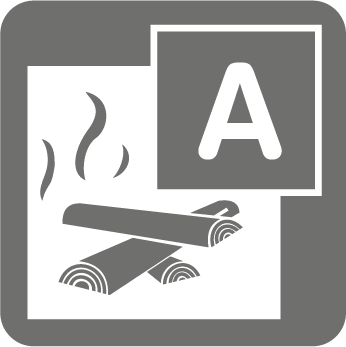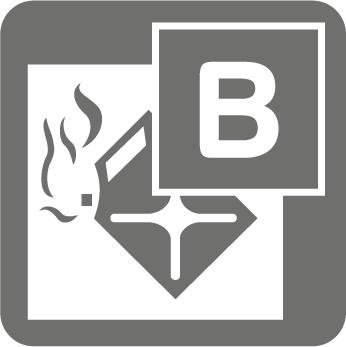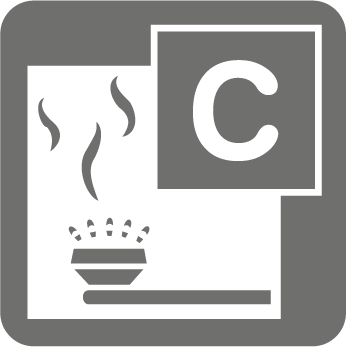Fire extinguishers and their extinguishing agents are divided into different fire classes according to DIN EN 2. Each fire class stands for certain material properties. This makes it possible to decide which fire extinguisher is suitable for which fire risk.
Fire class A
Fires of solid substances, mainly of an organic nature, which burn with the formation of embers
In addition to the generally known substances such as wood, paper, etc., also plastics, rubber in combination with textiles, e.g. car tyres, etc. Substances which only form embers, e.g. artificially degassed, also belong here.
Fire extinguishers suitable for fire class A: ABC powder fire extinguishers, foam fire extinguishers, water fire extinguishers.

Fire class B
Fires of liquid substances or substances that become liquid
This includes not only liquid substances but also substances that melt when heated (semi-solid substances), which burn like a liquid, i.e. where only the vapours can burn.
Fire extinguishers suitable for fire class B: ABC powder fire extinguishers, foam fire extinguishers, carbon dioxide fire extinguishers.

Fire class C
Fires of gases, e.g. methane, propane, hydrogen, acetylene, natural gas
These are only substances which are already present as gas in containers of any kind (steel cylinders, pipelines, boilers, etc.). Gases escaping or formed from other substances, e.g. during degassing of wood, are not included here.
Fire extinguishers suitable for fire class C: ABC powder fire extinguishers

Fire class D
Fires of metals, e.g. aluminium, magnesium, lithium, sodium, potassium and their alloys
potassium, sodium, calcium, lithium and barium. Only special extinguishing powders approved for fire class D can be used as extinguishing agents.
Fire extinguishers suitable for fire class D: Metal fire extinguishers

Fire class F
Fires of cooking oils and fats
Fires of cooking oils / fats (vegetable or animal oils and fats) in deep-frying and fat-baking equipment and other kitchen equipment and appliances.
Fire extinguishers suitable for fire class F: Grease fire extinguishers

Fire class E
Until 1978, fire class E in DIN 14406 described the suitability of a fire extinguisher for low-voltage installations up to 1,000 volts. With the 1978 edition of DIN 14406, however, fire class E was abolished and replaced by a danger notice. This notice is printed on the extinguisher's operating diagram and is located directly below the fire class symbols.
As a rule, all fire extinguishers (including water and foam fire extinguishers) can be used safely up to a voltage of 1,000 volts at a minimum distance of 1 metre
Schematic representation of the fire class suitability
The description of the fire classes shows that not every extinguisher is suitable for every fire class. When selecting a fire extinguisher, the actual fire classes must be taken into account.
 |  |  |  |  | |
|---|---|---|---|---|---|
Powder extinguishers | |||||
Foam extinguishers | |||||
Water extinguishers | |||||
CO2 extinguishers** | |||||
Wet chemical extinguishers*** | |||||
Metal fire extinguishers |
* The specification refers only to powder fire extinguishers which are also approved for the fire classes ABC. This does not apply to powder fire extinguishers with BC or D extinguishing powder.
** Although fires on electrical equipment belong to fire class A, carbon dioxide fire extinguishers are also often used for protection for control cabinets or EDP equipment. Provided the fire is detected in time, an attempt to extinguish it with carbon dioxide fire extinguishers can be successful.
*** The suitability for fire classes A and B for grease fire extinguishers depends on the extinguishing agent used. DÖKA grease fire extinguishers are basically suitable for fire classes AB and F.
The above table lists only the most common fire extinguishers and their extinguishing agents. In addition, there are a number of other types of fire extinguishers that are suitable for special applications, such as dust fires.
These extinguishers also show the pictogram of the respective fire class on the control panel, but the extinguishing properties are specially adapted to the requirements of the special approval.

